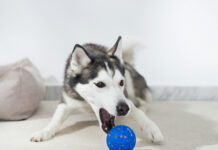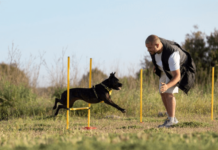Last Updated on March 18, 2024 by Dogs Vets
Training a stubborn dog can be a challenging and frustrating experience for many pet owners. These pets may exhibit a strong will, resistance to commands, or a lack of motivation, making the training process seem daunting.
However, with the right techniques, patience, and consistency, even the most obstinate dogs can learn to follow commands and become well-behaved companions.
In this blog post, we will explore effective training techniques for stubborn companions, focusing on positive reinforcement, clear communication, and building a strong bond between you and your canine friend.
Understanding Stubborn Behavior
Before diving into training techniques, it’s essential to understand the factors that may contribute to a fido’s unbending behavior.
Some dog breeds, such as terriers, hounds, and independent working breeds, may be more prone to stubborn behavior due to their instincts and traits. These breeds may require more patience and consistency in training to overcome their strong-willed tendencies.
Obstinate behavior can often stem from a lack of motivation. If a canine doesn’t find the training rewards or activities engaging enough, they may be less likely to participate or follow commands. Finding high-value rewards that truly motivate your pet is key to successful training.
Dogs thrive on clear, consistent communication. If training commands or expectations are inconsistent or unclear, a fido may become confused and appear stubborn. Ensuring that all family members use the same commands and reward systems can help alleviate this issue.
In some cases, stubborn behavior may be a result of underlying fear or anxiety.
If a dog associates a certain command or situation with a negative experience, they may resist or shut down. Addressing any underlying emotional issues with the help of a professional trainer or behaviorist can be crucial in these situations.
Positive Reinforcement Training
Positive reinforcement training is a highly effective approach for persistent canines, as it focuses on rewarding desired behaviors rather than punishing unwanted ones. This method helps build a strong, trusting bond between you and your companion while promoting enthusiasm for learning.
Identify rewards that truly motivate your dog, such as favorite treats, toys, or praise. Experiment with different types of rewards to find what works best for your pet.
High-value rewards should be reserved for training sessions and given immediately after your dog performs the desired behavior.
Shaping involves breaking down a complex behavior into smaller, more manageable steps and rewarding your fido for each successful step. This gradual approach can help stubborn dogs learn new behaviors without becoming overwhelmed or frustrated.
Luring involves using a treat or toy to guide your canine into the desired position or behavior. As your pet follows the lure, you can introduce the command and reward them for completing the action. Over time, you can fade out the lure and rely on the command alone.
Clicker training is a form of positive reinforcement that uses a small, handheld device to make a clicking sound to mark the precise moment your companion performs the desired behavior. The click is immediately followed by a reward, helping your dog associate the behavior with a positive outcome.
Clicker training can be particularly useful for obstinate dogs, as it provides clear, consistent communication and helps capture the exact behavior you want to reinforce.
Clear Communication and Consistency
Clear communication and consistency are essential when training stubborn dogs. Ensure that everyone in the household uses the same commands, hand signals, and reward systems to avoid confusion and maintain the dog’s trust in the training process.
Use short, clear commands that are easy for your pet to understand. Avoid using multiple words or phrases for the same behavior, as this can lead to confusion. Stick to simple, one-word commands like “sit,” “stay,” or “come.”
Consistency is key when training stubborn canines. Set clear expectations and stick to them, even in different environments or situations.
If you allow your companion to jump on the couch sometimes but not others, they may become confused and resistant to the “off” command. Maintaining consistency helps your dog understand what is expected of them and builds their confidence in the training process.
Timing is crucial when rewarding or correcting behaviors. Rewards should be given immediately after the desired behavior is performed to help your dog make the connection. Corrections, when necessary, should also be timely and consistent.
Repetition is essential for stubborn fidos, as they may require more practice to fully grasp a new command or behavior. Be patient and willing to repeat training sessions multiple times, gradually increasing the difficulty or distractions as your canine progresses.
Addressing Specific Challenges
Willful companions may present unique challenges during the training process. Here are some strategies for addressing common issues:
Building a reliable recall is crucial for unbending dogs, as it ensures their safety and your peace of mind. Start training in a low-distraction environment, using high-value rewards and gradually increasing the distance and distractions. If your pet struggles with recall, consider using a long line or retractable leash to maintain control while practicing.
Stubborn canines may pull on the leash or resist walking calmly by your side.
To address this, use positive reinforcement techniques like treating your dog when they are in the desired position, stopping and changing direction when they pull, and using a front-clip harness or head halter for added control. Consistency and patience are key when teaching loose-leash walking.
Proofing involves practicing commands in various environments and situations to ensure your companion can perform them reliably, even with distractions.
Start training in low-distraction areas and gradually increase the difficulty by adding new people, animals, or environments. This process helps obstinate dogs generalize their learning and respond to commands consistently.
Seeking Professional Help
If you find yourself struggling to make progress with your stubborn pet or encountering specific behavioral issues, don’t hesitate to seek professional help. A certified canine trainer or behaviorist can provide personalized guidance and support tailored to your dog’s unique needs.
In some cases, tools like a dog training shock collar, also known as an e-collar, may be recommended by a professional trainer to address specific challenges or reinforce commands in highly distracting environments.
However, it’s crucial to use these tools responsibly, under the guidance of a qualified trainer, and always in combination with positive reinforcement techniques. The goal should be to phase out the use of such tools as your fido’s training progresses and rely primarily on rewards and clear communication.
Closing Thoughts
Training a stubborn dog requires patience, consistency, and a commitment to positive reinforcement techniques.
By understanding the factors contributing to your dog’s willful behavior, using high-value rewards, providing clear communication, and addressing specific challenges, you can help your strong-willed canine become a well-behaved and responsive companion.
Remember, every pet is unique, and progress may take time. Celebrate the small victories along the way and cherish the bond you are building with your persistent yet lovable companion.
With dedication and the right approach, you can unlock your dog’s full potential and enjoy a harmonious relationship built on trust, respect, and understanding.
Fact Check
We strive to provide the latest valuable information for pet lovers with accuracy and fairness. If you would like to add to this post or advertise with us, don’t hesitate to reach us. If you see something that doesn’t look right, contact us!

















